Fluid Mechanics for MAP/Fluid Dynamics
< Fluid Mechanics for MAP>back to Chapters of Fluid Mechanics for MAP
>back to Chapters of Microfluid Mechanics
Introduction
Differential Approach seek solution at every point  , i.e describe the detailed flow pattern at all points.
, i.e describe the detailed flow pattern at all points.
Integral approach for a Control Volume (CV) is interested in a finite region and it determines gross flow effects such as force or torque on a body or the total energy exchange. For this purpose, balances of incoming and outgoing flux of mass, momentum and energy are made through this finite region. It gives very fast engineering answers, sometimes crude but useful.
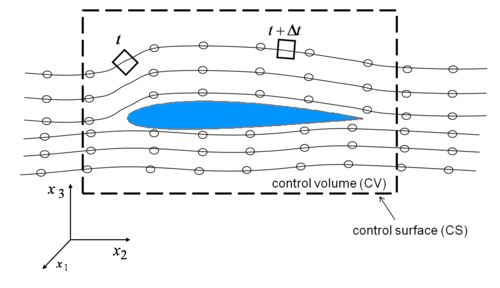
Lagrangian versus Eulerian Approach: Substantial Derivative
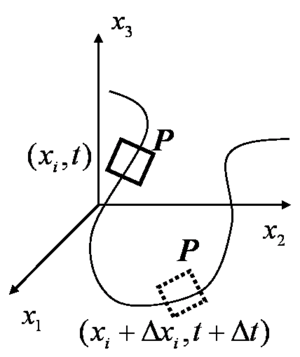
Let  be any flow variable (pressure, velocity, etc.). Eulerian approach deals with the description of
be any flow variable (pressure, velocity, etc.). Eulerian approach deals with the description of  at each location
at each location  and time (t). For example, measurement of pressure at all
and time (t). For example, measurement of pressure at all  defines the pressure field:
defines the pressure field:  . Other field variables of the flow are:
. Other field variables of the flow are:

Lagrangian approach tracks a fluid particle and determines its properties as it moves.

Oceanographic measurements made with floating sensors delivering location, pressure and temperature data, is one example of this approach. X-ray opaque dyes, which are used to trace blood flow in arteries, is another example.
Let  be the variable of the particle (substance) P, this
be the variable of the particle (substance) P, this  is called "substantial variable".
is called "substantial variable".
For this variable:
 and
and 
In other words, one observes the change of variable  for a selected amount of mass of fixed identity, such that for the fluid particle, every change is a function of time only.
for a selected amount of mass of fixed identity, such that for the fluid particle, every change is a function of time only.
In a fluid flow, due to excessive number of fluid particles, Lagrangian approach is not widely used.
Thus, for a particle P finding itself at point  for a given time, we can write the equality with the field variable:
for a given time, we can write the equality with the field variable:
![\displaystyle \alpha_{p}(t) = \alpha \left[(x_{i})_{p},t\right]](../I/m/a0146116dc57df5d27640e63c09ec050.png)
Along the path of the particle:
![\displaystyle \alpha_{p}(t + \Delta t) = \alpha \left[(x_{i} + \Delta x_{i})_{p}, t + \Delta t\right]](../I/m/f39a678eb6e2d95e9b7d51e01008d51b.png)
Hence,
![\displaystyle d\alpha_{p} = \alpha \left[((x_{i} + \Delta x_{i})_{p}, t + \Delta t) - \alpha ((x_{i})_{p},t)\right]](../I/m/7a8cc6c2b09480b5294318e0d6db4753.png)


The local change in time is the local time derivative (unsteadiness of the flow) and the change in space is the change along the path of the particle by means of the convective derivative.

The substantial derivative connects the Lagrangian and Eulerian variables.
System versus Control volume
In mechanics, system is a collection of matter of fixed identity (always the same atoms or fluid particles) which may move, flow and interact with its surroundings.
Hence, the mass is constant for a system, although it may continually change size and shape. This approach is very usefull in statics and dynamics, in which the system can be isolated from its surrounding and its interaction with the surrounding can be analysed by using a free-body diagram.
In fluid dynamics, it is very hard to identify and follow a specific quantity of the fluid. Imagine a river and you have to follow a specific mass of water along the river.
Mostly, we are rather interested in determining forces on surfaces, for example on the surfaces of airplanes and cars. Hence, instead of system approach, we identify a specific volume in space (associated with our geometry of interest) and analyse the flow within, through or around this volume. This specific volume is called "Control Volume". This control volume can be fixed, moving or even deforming.
The control volume is a specific geometric entity independent of the flowing fluid. The matter within a control volume may change with time, and the mass may not remain constant.

Basic laws for a system
Conservation of mass
The mass of a system do not change:

where, 
Newton's second law
For a system moving relative to a inertial reference frame, the sum of all external forces acting on the system is equal to the time rate of change of linear momentum ( ) of the system:
) of the system:


The first law of Thermodynamics

in the rate form:

where 
and 
There are also other laws like the conservation of moment of momentum (angular momentum) and second law of thermodynamics, but they are not the subject of this course and will not be treated here.
Note that all basic laws are written for a system, i.e defined mass with fixed identity. We should rephrase these laws for a control volume.
Relation of a system derivative to the control volume derivative
|
Consider a fire extinguisher
whereas We would like to relate
The variables appear in the physical laws (balance laws) of a system are:
They are called extensive properties. Let 
   |
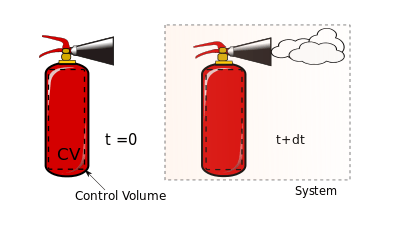 Control Volume versus System |
One dimensional Reynolds Transport Theorem
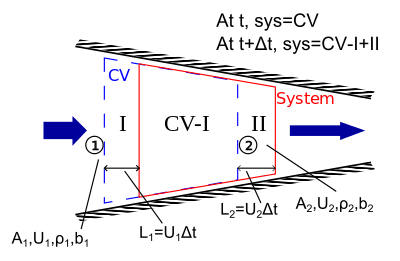
Consider a flow through a nozzle.
If  is an extensive variable of the system.
is an extensive variable of the system.



The first term for 

 for
for 



Similarly

Thus, for  , the terms in the equality for the time derivative of the system are
, the terms in the equality for the time derivative of the system are



so that,

This is the equation of 1 dimensional Reynolds transport theorem (RTT).
|
The three terms on the RHS of RTT are: 1. The rate of change of B within CV indicates the local unsteady effect. 2. The flux of B passing out of the CS. 3. The flux of B passing into the CS. There can be more than one inlet and outlet. Three Dimensional Reynolds Transport TheoremHence, for a quite complex, unsteady, three dimensional situation, we need a more general form of RTT. Consider an arbitrary 3-D CV and the outward unit normal vector  
  Since  It is possible that CV can move with constant velocity or arbitrary acceleration. This form of RTT is valid if the CV has no acceleration with respect to a fixed (inertial) reference frame. RTT is then valid for a moving CV with constant velocity when: 1. All velocities are measured relative to the CV. 2. All time derivative measure relative to the CV.

|
 CV with multiple inlets and outlets 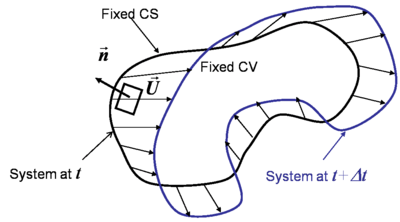 CV with arbitrary shape used to derive Reynolds transport theorem 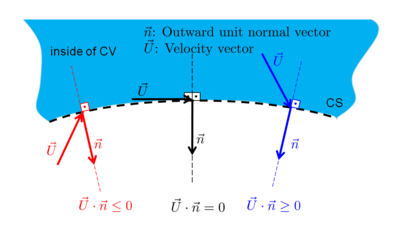 Sign of the inflow and outflow fluxes to the CV 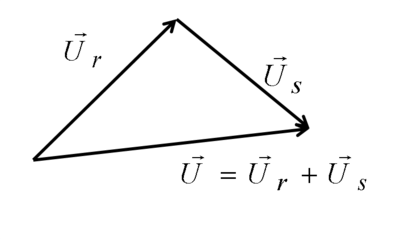 Relation between the absolute velocity vector with the velocity of the moving reference frame and the velocity w.r.t. to the moving reference frame |
Conservation of mass


i.e

Assume  = constant (incompressible)
= constant (incompressible)

As  of CV is also constant, the time derivative drops out:
of CV is also constant, the time derivative drops out:

The net volume flow rate should be zero through the control surfaces.
Note that we did not assume a steady flow. This equation is valid for both steady and unsteady flows.
If the flow is steady,

there is no-mass accumulation or deficit in the control volume.
Linear Momentum equation for inertial control volume
 ,
, 


This equation states that the sum of all forces acting on a non-accelerating CV is equal to the sum of the net rate of change of momentum inside the CV and the net rate of momentum flux through the CS.
Force on the system is the sum of surface forces and body forces.

The surface forces are mainly due to pressure, which is normal to the surface, and viscous stresses, which can be both normal or tangential to the surfaces.


The body forces can be due to gravity or magnetic field.
at the initial moment 

i.e. in component form:

First law of Thermodynamics


at the initial moment  , the following equality is valid:
, the following equality is valid:
![\displaystyle \frac{dE}{dt}_{system} = [\dot{Q} + \dot{W}]_{system} = [\dot{Q} + \dot{W}]_{cv}](../I/m/f9e8369d6822fadc95f798d35d9a965e.png)
thus, the integral form of energy equation is:
![\displaystyle [\dot{Q} + \dot{W}]_{cv}= \frac{\partial}{\partial t}\int_{cv}{e\rho dV} + \int_{cs}{e\rho \vec{U}\cdot\vec{n}dA}](../I/m/4a0fa481e8976e18c58f09566b289359.png)
Examples
Example 1Consider the mass balance in a stream tube by using the integral form of the conservatin of mass equation. Let 

   |
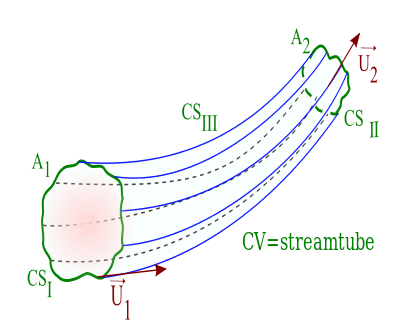 Mass balance for stream tube inside a laminar flow |
Example 2
|
Consider the steady flow of water through the device. The inlet and outlet areas are The following parameters are known: Mass flow out at 3 ( Volume flow rate in through 4 ( Velocity at 1 along

 |
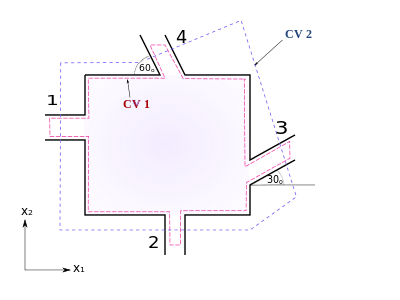 mass balance for a connector device Hence, the velocity at section 2 can be calculated by
|
Example 3
|

 
 |
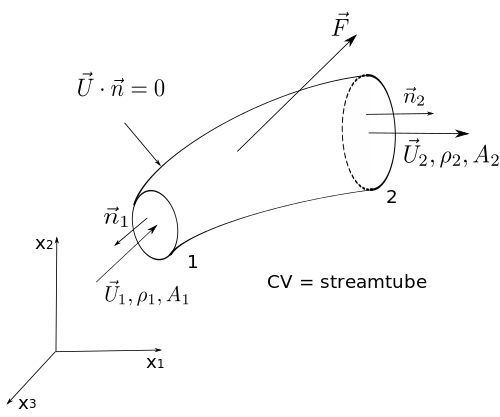 Force in a streamtube |
Example 4
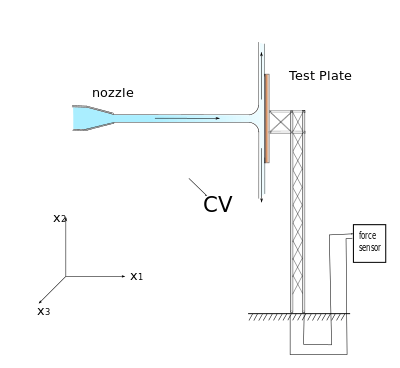
Water from a stationary nozzle strikes to a plate. Assume that the flow is normal to the plate and in the jet velocity is uniform. Determine the force on the plate in  direction.
direction.
Independent from the selected CV.


No body force in  direction.
direction.



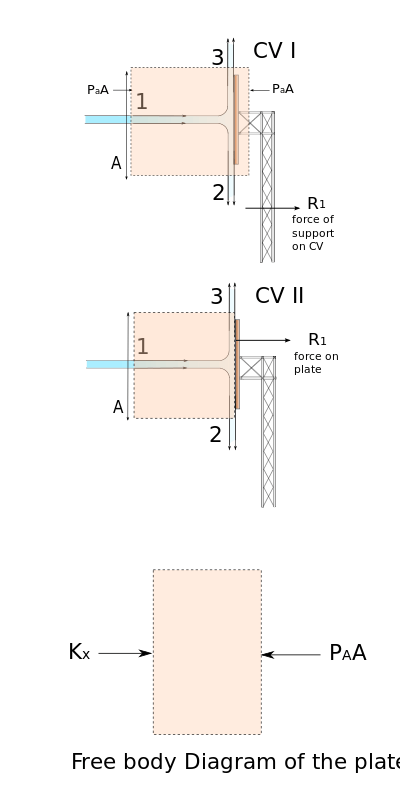
 at 2 and 3.
at 2 and 3.

The force which acts on the plate (action-reaction) is 
It is also possible to solve the problem with 


Hence, the force exerted on the plate by the CV is




Example 5
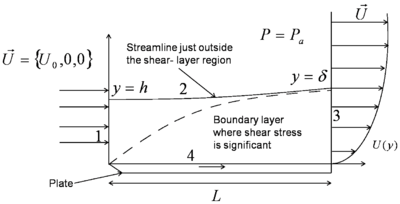
Consider the plate exposed to uniform velocity. The flow is steady and incompressible. A boundary layer builds up on the plate. Determine the Drag force on the plate. Note that  can be approximated at L.
can be approximated at L.

Apply conservation of mass







Insert the mass conservation result into the momentum equation.

 is known.Here,using
is known.Here,using 

Example 6
|
Note that for an inertial CV (static or moving with constant speed) RTT is valid, but velocities should be written with respect to the moving CV.      from continuity,       for    
     |
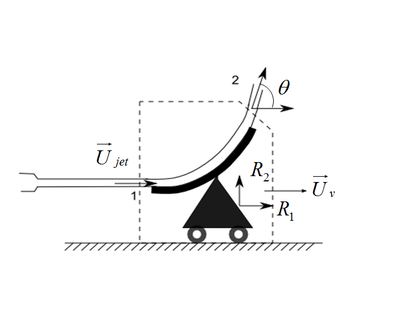 |
Momentum Equation for CV with rectilinear acceleration
For an inertial CV the following transport equation for momentum holds:

However, not all CV are inertial: for example a rocket must accelerate if it is to get off the ground.
Denote an inertial reference frame with  and another reference frame moving with the system
and another reference frame moving with the system  . Hence,
. Hence,  becomes the non-inertial frame of reference. Let the system to move with a velocity and an acceleration
becomes the non-inertial frame of reference. Let the system to move with a velocity and an acceleration  and
and  respectively. Here
respectively. Here  and accordingly with time derivative dt,
and accordingly with time derivative dt,

or,

These above relationship implies that the velocity and the acceleration is not same when considered from inertial and moving reference frame. The Newton's second law states that:

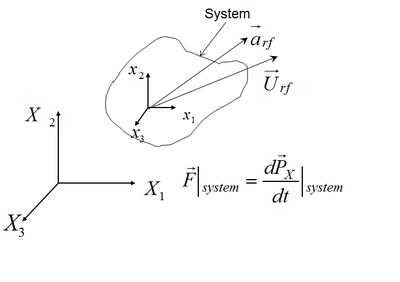
Thus the following relation holds for the fluid velocity in the system

Where  is the velocity of the fluid in the system with respect to a non-inertial reference frame,
is the velocity of the fluid in the system with respect to a non-inertial reference frame,  is the velocity of the fluid in the system with respect to the inertial reference frame. Accordingly, the acceleration reads:
is the velocity of the fluid in the system with respect to the inertial reference frame. Accordingly, the acceleration reads:


For a control volume moving with  and
and 

Thus for cases, where  , the time derivative of
, the time derivative of  and
and  are not equal for a system accelerating relative to an inertial reference frame, i.e. RTT is not valid for an accelerating control volume.
are not equal for a system accelerating relative to an inertial reference frame, i.e. RTT is not valid for an accelerating control volume.
To develop momentum equation for an accelerating CV, it is necessary to relate  to
to  .
.
Previously we have seen that in a non-inertial reference frame having rectilinear acceleration, i.e. (translational acceleration).

and also





For a moving CV we know that

Let system and CV coincides at an instant  :
:


Examples
Example 1
|
A small rocket, with an inertial mass of Neglecting drag on the rocket, find the relation for the velocity of the rocket U(t). 
  
  |
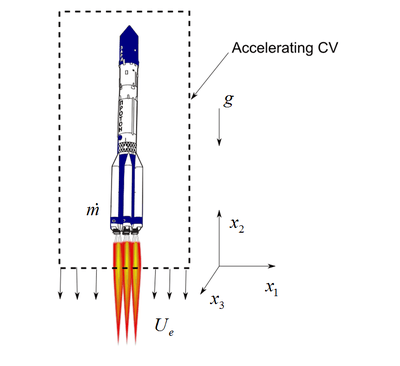 |
|
is the time rate of change at 
![\displaystyle \frac{\partial}{\partial t}\left[\underbrace{\int_{CVI}{U_{2}\rho dV}}_{U_{2}=0\rightarrow = 0} + \int_{CVII}{U_{2}\rho dV}\right] = \frac{\partial}{\partial t}\int_{CVII}{U_{2}\rho dV}\approx 0](../I/m/adcdb77196f296ee98440bcc150402af.png) D: 
    
|
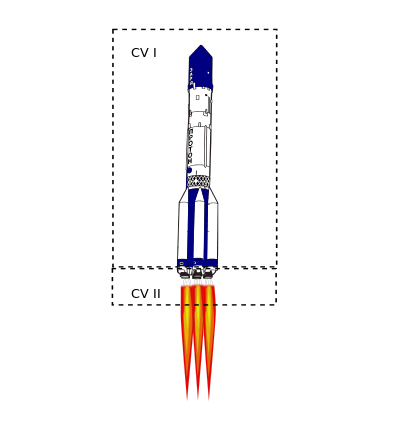 Control Volume I and II |
Extension of Energy equation for CV
![\displaystyle
\left[\dot{Q} + \dot{W}\right]_{on\ system} = \left[\dot{Q} + \dot{W}\right]_{on\ cv} = \frac{\partial}{\partial t}\int{e\rho\ dV} + \int_{cs}{e\rho \vec{U}\cdot\vec{n}dA}](../I/m/3f063f14f13bde94e321bc4562979f2c.png)
where 

here 


 is the stress in the plane of dA.
is the stress in the plane of dA.
|

   
 |
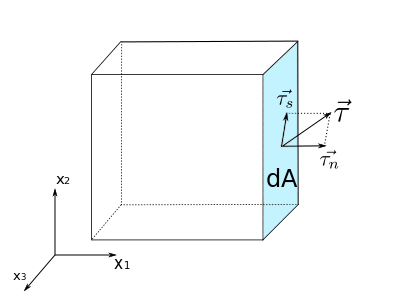 Shear and Normal stress component on the surface element dA / |
Examples
Example 1
|
 

 ![\displaystyle \dot{Q} = -\dot{W}_{shaft} + \dot{m}\left[h_{2} + \frac{U_{2}^{2}}{2} - h_{1} + \underbrace{g(z_{2} - z_{1})}_{=\ 0}\right]](../I/m/9541074cf02ec6c8fd3ed3b810ccab68.png)
 ![\displaystyle \dot{Q} = -\dot{W}_{shaft} + \dot{m}\left[c_{p}(T_{2} - T_{1}) + \frac{U_{2}^{2}}{2}\right]](../I/m/1ac78a4e68adf31670fce8b6e25b5a9f.png) |
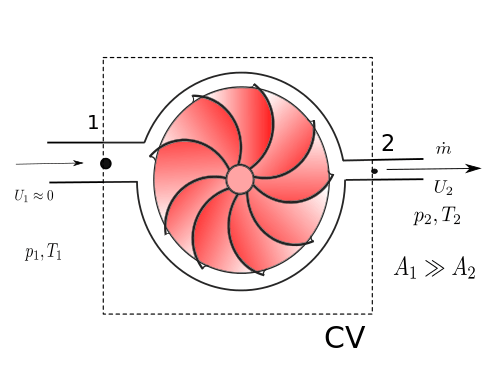 Energy balance for a compressor |
Special form of the Energy equation
For a CV with one inlet 1, one outlet 2 and steady uniform flow through it.

For uniform flow properties at the inlet and outlet.

![\displaystyle K = \dot{m}\left[(u_{2} - u_{1}) + \left(\frac{p_{2}}{\rho_{2}} - \frac{p_{1}}{\rho_{1}}\right) + \left(\frac{\vec{U}_{2}^{2}}{2} - \frac{\vec{U}_{1}^{2}}{2}\right) + g(z_{2} - z_{1})\right]](../I/m/e70e8cd8a753e51aba9c4e0af0f5758f.png)
Reform:

For  ,
,  and incompressible flow:
and incompressible flow:

 : Mechanical energy per unit mass.
: Mechanical energy per unit mass.
 : Irreversible conversion of mechanical energy to unwanted thermal energy
: Irreversible conversion of mechanical energy to unwanted thermal energy  and loss of energy via heat transfer
and loss of energy via heat transfer  .
.
Thus with this equation I can calculate the loss of energy through a device.
![\displaystyle h_{loss} = \left[u_{2} - u_{1} -\frac{\dot{Q}}{\dot{m}}\right]\frac{1}{g}](../I/m/ed98bfa38688f07421ff369366c54754.png)
i.e.

One can add the work done by a pump or a turbine.

Differential Control Volume Analysis:Bernoulli Equation
|
Continuity   Component of Momentum Equation    |
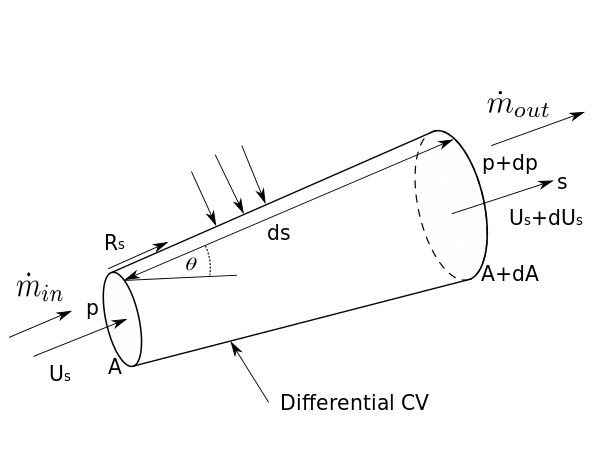 Differential control volume for Bernoulli's Equation |
 with:  Then,     where   with:  Then,  |
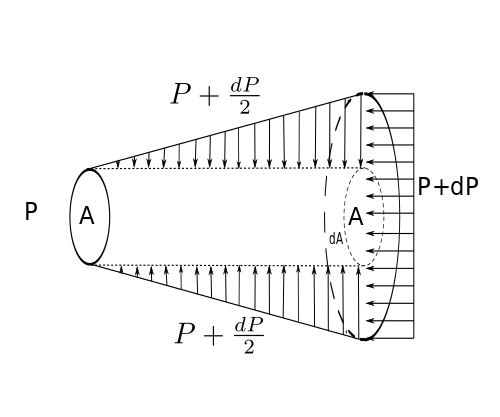 Pressure Distribution on fluid element |
Integrate between 1 and 2 along a streamline:

Bernoulli equation is clearly related to the steady flow energy equation for a stream line. This form of the Bernoulli equation, when the following conditions are satisfied:
1. Steady flow. Note that theres is also an unsteady Bernoulli equation.
2. Incompressible flow. For example, in aerodynamics, flow can be accepted to be incompressible for Mach number  less than 0.3.
less than 0.3.
3. Frictionless flow, e.g. in the absence of solid walls.
4. Flow along a single streamline. Different streamline has a different constant.
5. No shaft work between 1 and 2.
6. No heat transfer between 1 and 2.

Examples
Example 1
|
 
     |
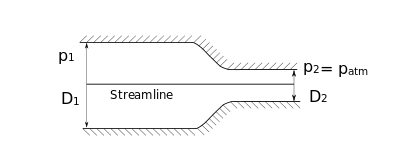 Flow through horizontal nozzle |
Example 2
|
    ![\displaystyle U_{2}^{2}\left[1 - \left(\frac{A_{2}}{A_{1}}\right)^{2}\right] = 2gh](../I/m/1268209b878f4e41040c670b26c0b5c7.png) ![\displaystyle U_{2}^{2} = \frac{2gh}{\left[1 - \left(\frac{A_{2}}{A_{1}}\right)^{2}\right]}](../I/m/a2c8284a4373cd460a38f5870272f83f.png)
 |
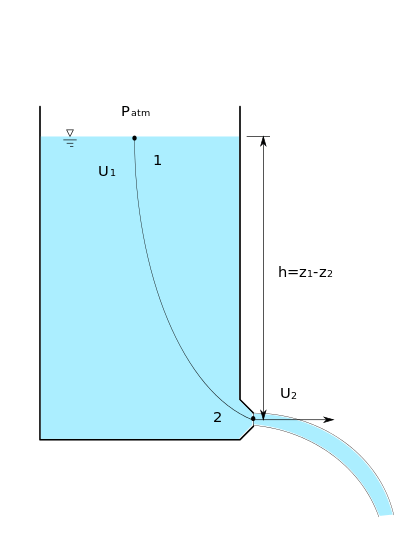 Nozzle discharge velocity at the bottom of the tank |
Example 3
Find a relationship between the flow rate and the pressure difference inside a pipe which could be measured by venturimeter
      

|
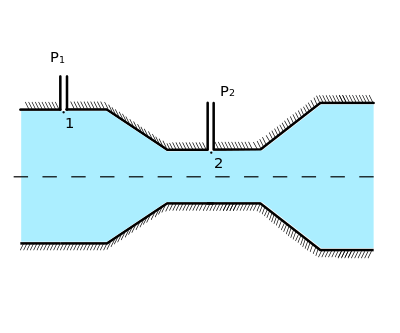 Application of Bernoulli Equation:Venturimeter |


 to
to 
 ),
), ),
), ),
), ),
), ).
). is the extensive property per unit mass:
is the extensive property per unit mass: defined at each point on the CS. The outflow and inflow flux of
defined at each point on the CS. The outflow and inflow flux of  across CS can be written as:
across CS can be written as: and
and  are positive quantities. Therefore,
the negative sign is introduced into
are positive quantities. Therefore,
the negative sign is introduced into  .
. , RTT can be written as:
, RTT can be written as:

 and
and  be too small such that the velocities
be too small such that the velocities  at position 1 and 2 are uniform across
at position 1 and 2 are uniform across  is zero, because there is no flow across the streamtube. Thus,
is zero, because there is no flow across the streamtube. Thus, =
=  .
. ).
). ).
). ,
,  so that
so that  .
. At section 3:
At section 3:

![\displaystyle \int_{A_{2}}{\rho \vec{U}_2\cdot\vec{n}_2dA} = -\left[-\rho\left|U_{1}\right|A_{1} + \dot{m}_{3} - \rho Q_{4}\right]](../I/m/d91b32925792b823a28e2fc9d9beccc7.png)


 is negative (outflow) and it is negative if
is negative (outflow) and it is negative if 
 in
in 
 and at 2,
and at 2,  .
. , is to be launched vertically. Assume a steady exhaust mass flow rate
, is to be launched vertically. Assume a steady exhaust mass flow rate  and velocity
and velocity  relative to the rocket.
relative to the rocket. -momentum of the fluid in CV. One can treat the rocket CV as if it is composed of two CV's, i.e. the solid propellant section (CVI) and nozzle section (CVII):
-momentum of the fluid in CV. One can treat the rocket CV as if it is composed of two CV's, i.e. the solid propellant section (CVI) and nozzle section (CVII): does not change in time at the nozzle and the mass in CVII does not change in time, this term can be neglected completely:
does not change in time at the nozzle and the mass in CVII does not change in time, this term can be neglected completely: . To overcome gravity one should have enough exit velocity, i.e. momentum. Moreover, it can be seen from this equation that if the fuel mass burned is a large fraction of the initial mass, the final rocket velocity can exceed the exit velocity of the fluid.
. To overcome gravity one should have enough exit velocity, i.e. momentum. Moreover, it can be seen from this equation that if the fuel mass burned is a large fraction of the initial mass, the final rocket velocity can exceed the exit velocity of the fluid. is the normal stress normal to dA.
is the normal stress normal to dA. and the volume flow rate is
and the volume flow rate is  .
. .
. .
.
 as a function of flow rate
as a function of flow rate  .
. , uniform flow.
, uniform flow. , thus,
, thus, , then:
, then: